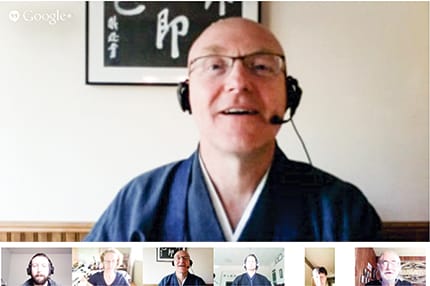Dosho Port discusses the emerging trend of online sanghas, and whether the dharma can be practiced digitally.

The Internet has transformed sanghas. Buddhists who have been geographically isolated with little access to teachers and senior practitioners for guidance now have teachers and entire communities at their fingertips. Information and opinions about dharma centers, teachers, and sanghas are also readily available to practitioners worldwide, effectively leveling the dharma field and deflating notions of specialness.
But does all that accessibility build dharma community and lead to insight? As someone who teaches dharma online, I’ve taken a particular interest in this question.
Vine of Obstacles: Online Support for Zen Training, my online project, like other online communities, offers Zen practice and the opportunity to work with a teacher without leaving home. This is especially meaningful for those with no zendo nearby or with mobility issues.
My students tell me that through their online interactions they have found a sense of connection, an affirmation that they are not alone in the difficult work of cultivating practice in daily life. This matters. However, an equally important “polishing stones” aspect of dharma community life, in which practice is a team sport and we learn by working together, is not fully present in online dharma communities and can be difficult to replicate in the virtual world—or, for that matter, outside of the monastic container.
Online or in a physical zendo, zazen remains the heart of the practice. Vine of Obstacles practitioners report that online sitting carries with it some of the same advantages of sitting with a group, such as accountability and continuity of practice. When the time comes for morning zazen, it is not as easy to roll over and punch the snooze button.
Learning to sit, however, can be quite difficult without close contact with a teacher or community. Given the limitations of video, it’s challenging for students to do precisely what someone else is doing on-screen; for teachers, physical adjustments aren’t an option. For both, it is impossible to get the somatic sense of sitting with another person.
We have tried to address these limitations by having a forum where practitioners can send pictures that I then mark with feedback. This approximates in-person work to an extent, yet there’s nothing like someone actually adjusting your floating-in-the-clouds head by gently tipping it forward or moving your torso—that you imagined to be vertically upright—six inches to the left. The power of embodied sitting with a group and a teacher cannot be fully replicated when only a couple of sense avenues, not including the body sense, are available.
In the lineage of my first teacher, Dainin Katigiri Roshi, dharma study is an important aspect of Zen. It is also one of the significant strengths of the cyber world. Online course work can be designed in a way that engages students in active learning and makes use of a wide range of resources. This is a major upgrade from the passive teaching style prevalent in most physical zendos, where the teacher talks and students nod. In addition, curricula can be personalized, sequenced, and scaffolded to maximize learning, drawing on a modern understanding of what constitutes effective education.
Online teachers rely on Skype and other videoconferencing tools to maintain contact and communication with their students. It can be an effective mode of coming together, but because there are only a couple of sense channels working—visual and auditory—I’ve found that online meetings need to be much longer than traditional dokusan, which might last just a few minutes.
The Internet is not a perfect medium for dharma, but it clearly offers some tangible benefits. Still, an important question remains: Is waking up possible through purely virtual connections with a teacher and community? The answer may depend on what “waking up” means to you.
For those engaged in just-sitting Zen, which is so physical and relies strongly on group practice, the answer may be no. Waking up online—except in the sense that we’re all already awake—may not be possible. But I think the conversation changes when we turn to koan practice. Students I’ve worked with only online have realized kensho; the medium, for them, seems to be less limiting.
Distant though it may be from the monastic practice at the heart of this tradition, online dharma work can be authentic. And we have only begun to explore the shapes it might take. I envision a not-too-distant future in which more and more practitioners, even with close access to teachers and communities, embrace a hybrid option, one that includes the intimacy of in-person work while exploring the possibilities and freedom of cyberdharma. To move beyond limitations in our practice—isn’t that the point?
